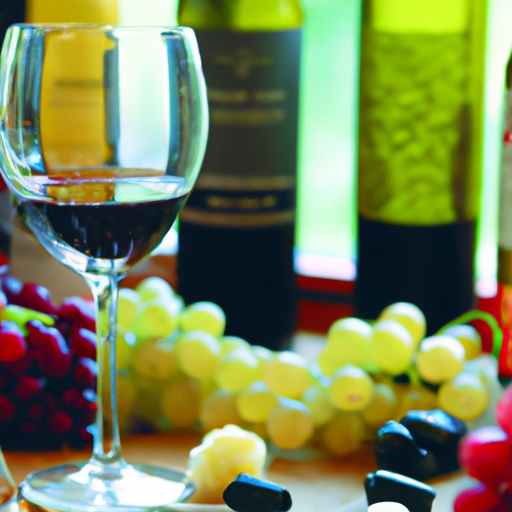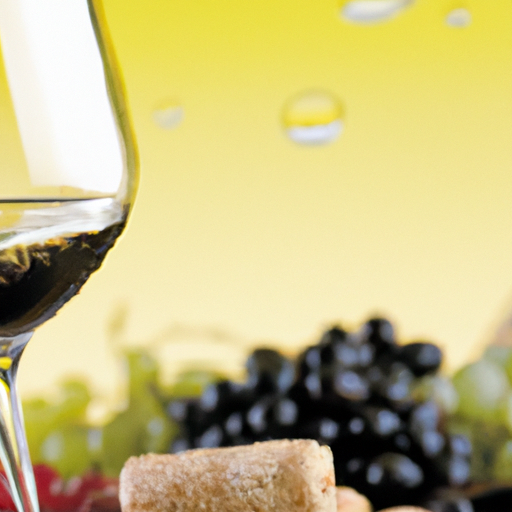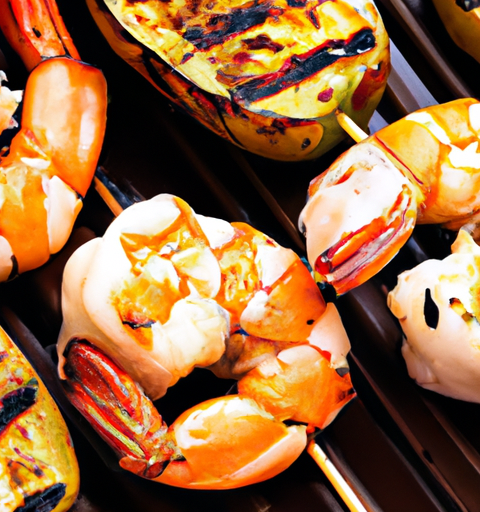Have you ever wondered which food is the best match for a glass of wine? Well, you’re in luck! In this article, we’re going to delve into the world of food and wine pairings and discover some of the best combinations that will tantalize your taste buds. So, if you’re a foodie who enjoys sipping on a glass of vino, keep reading to learn more about the art of pairing food with wine.
When it comes to pairing food with wine, there are a few golden rules to follow. Firstly, consider the intensity of both the food and the wine. Light-bodied wines such as Sauvignon Blanc go well with light, delicate dishes like seafood or salads, while full-bodied wines like Cabernet Sauvignon or Malbec pair beautifully with hearty dishes like steak or rich stews. Secondly, take note of the flavors and characteristics of the wine. Is it fruity and acidic, or more earthy and robust? Matching these flavors with complementary foods can bring out the best in both. In our upcoming article, we’ll delve even further into this topic, exploring specific wine varietals and their ideal food pairings. So, get ready to enhance your dining experience with the perfect food and wine combinations!
The Best Food Pairings for Wine
Pairing food with wine can elevate the taste and overall dining experience. Whether you’re hosting a dinner party, going out to a fancy restaurant, or simply enjoying a meal at home, choosing the right wine to complement your dish can make all the difference. In this article, we will explore the basics of food and wine pairing, classic wine and food combinations, regional pairings, cheese pairings, vegetarian and vegan pairings, dessert and wine pairings, pairings with spicy foods, seasonal pairings, and even some unconventional pairings. So let’s dive in and discover the best food pairings for wine!

Food and Wine Pairing Basics
To successfully pair food and wine, it’s important to consider various factors like acidity, flavors and intensities, weight and texture, and sweetness levels. Understanding how these elements interact can help you create a harmonious balance of flavors in your mouth.
Understanding the role of acidity
Acidity is a crucial component in both food and wine. High-acidity wines like Sauvignon Blanc or Chianti can cut through the richness of fatty foods like buttery seafood dishes or grilled red meat. On the other hand, dishes with higher acidity levels like salads or seafood pair well with wines that have a crisp acidity, such as Sauvignon Blanc or Albariño.
Matching flavors and intensities
Aim to pair foods and wines that have complementary flavors. For example, the earthy notes of mushrooms in a dish would pair wonderfully with a Pinot Noir, while the fresh and zesty flavors of a seafood salad would be enhanced by a crisp Sauvignon Blanc. Additionally, it’s important to consider the intensity of both the dish and the wine. Light-bodied dishes like roasted vegetables are best paired with lighter wines such as Merlot, while bold and hearty dishes like grilled red meat call for a full-bodied Cabernet Sauvignon.
Pairing based on weight and texture
The weight and texture of both the food and wine can greatly influence how well they pair together. Rich and creamy dishes like buttery seafood are complemented by the full-bodied and buttery texture of a Chardonnay. In contrast, lighter dishes like fresh salads or light vegetable-based dishes are best paired with light-bodied white wines like Sauvignon Blanc or Riesling.
Considering sweetness levels
When it comes to pairing sweet foods with wine, it’s essential to consider the level of sweetness in both. A general rule of thumb is to pair sweet desserts with wines that are sweeter or have higher acidity. For example, a rich chocolate dessert would pair nicely with a Port or Cabernet Sauvignon, while fruit-based desserts like a tart apple pie would be complemented by a sweet Riesling or Moscato.
Classic Wine and Food Pairings
Certain wine and food combinations have withstood the test of time and have become classic pairings that are loved by many. Here are some tried-and-true combinations that are sure to delight your taste buds:
Chardonnay with buttery seafood dishes
The buttery and rich flavors of dishes like lobster or shrimp scampi are beautifully complemented by a creamy and full-bodied Chardonnay. The wine’s buttery texture and hints of oak enhance the flavors of the seafood, creating a decadent dining experience.
Cabernet Sauvignon with grilled red meat
The bold and intense flavors of a juicy grilled steak or lamb chop are perfectly paired with a robust and full-bodied Cabernet Sauvignon. The wine’s tannins help to cut through the fattiness of the meat, while its dark fruit flavors complement the richness of the dish.
Sauvignon Blanc with fresh salads and seafood
The crisp and refreshing acidity of a Sauvignon Blanc is an excellent match for light and refreshing dishes like salads or seafood. The wine’s citrusy and herbal notes enhance the flavors of the ingredients, resulting in a vibrant and balanced pairing.
Merlot with roasted vegetables and softer cheeses
Roasted vegetables have a natural sweetness and earthiness that pairs beautifully with the fruit-forward flavors of a Merlot. The wine’s soft tannins and medium body complement the flavors of the vegetables without overpowering them. Additionally, Merlot pairs well with softer cheeses like Camembert or Brie.
Pinot Noir with earthy mushrooms and truffled dishes
The delicate and nuanced flavors of a Pinot Noir are a perfect match for dishes featuring earthy mushrooms or truffle-infused ingredients. The wine’s vibrant acidity and red fruit flavors harmonize with the flavors of the mushrooms, creating a sublime pairing that is both elegant and satisfying.
Regional Pairings
Different cuisines have their own unique flavors and ingredients, which can greatly influence the choice of wine. Here are some regional pairings that highlight the best of both worlds:
Italian cuisine and Chianti or Sangiovese
Italian dishes are known for their rich flavors and use of tomatoes, garlic, herbs, and olive oil. Chianti, made primarily from the Sangiovese grape, pairs exceptionally well with tomato-based sauces, grilled meats, and aged cheeses. The wine’s high acidity and firm tannins cut through the richness of the dishes, creating a perfect balance.
French dishes and Bordeaux or Burgundy wines
French cuisine encompasses a wide range of flavors and techniques. Bordeaux wines, known for their blend of Cabernet Sauvignon, Merlot, and Cabernet Franc, complement rich and flavorful dishes like coq au vin or boeuf bourguignon. Burgundy wines, made from Pinot Noir or Chardonnay grapes, pair beautifully with dishes featuring buttery sauces, seafood, or poultry.
Spanish tapas and Rioja or Albariño wines
Spanish tapas are diverse and bursting with flavor. Rioja, made primarily from Tempranillo grapes, is a perfect companion for dishes like patatas bravas, chorizo, or grilled lamb. Its medium body and balanced acidity enhance the smoky and spicy flavors of tapas. Albariño, on the other hand, is a crisp and aromatic white wine that pairs wonderfully with seafood-based tapas or paella.
Mexican food and Malbec or Zinfandel
Mexican cuisine is known for its bold and spicy flavors. Malbec, with its rich and fruit-forward characteristics, complements dishes like carne asada or spicy mole. The wine’s medium to full body and soft tannins tame the heat of the spices, creating a harmonious pairing. Zinfandel, with its ripe fruit flavors and peppery nuances, is also a great match for Mexican dishes like enchiladas or carne adovada.
Asian flavors and Riesling or Gewürztraminer
Asian cuisines like Thai, Chinese, or Indian have their own unique blend of flavors, spices, and aromas. Riesling, with its vibrant acidity and touch of sweetness, pairs well with spicy dishes like green curry or General Tso’s chicken. Gewürztraminer, with its exotic aromas and spicy undertones, complements dishes like Szechuan shrimp or Indian curry.
Pairing Wine with Cheese
The combination of wine and cheese is a classic pairing that has been enjoyed for centuries. The flavors and textures of different cheeses can greatly influence which wine to choose. Here are some popular cheese pairings:
Soft and creamy cheeses with Champagne
The delicate bubbles and crisp acidity of Champagne cut through the creaminess of soft cheeses like Brie or Camembert. The wine’s toasty notes and hints of citrus create a refreshing and palate-cleansing experience.
Sharp and aged cheeses with bold red wines
Bold and aged cheeses like Cheddar or Gouda pair wonderfully with full-bodied red wines like Cabernet Sauvignon or Syrah. The wine’s tannins and dark fruit flavors complement the intense flavors of the cheese, resulting in a robust and satisfying combination.
Goat cheese with Sauvignon Blanc or Chenin Blanc
The tangy and slightly acidic flavors of goat cheese are beautifully balanced by the crisp acidity of white wines like Sauvignon Blanc or Chenin Blanc. The wine’s citrusy and herbal notes enhance the flavors of the cheese, creating a harmonious and refreshing pairing.
Blue cheeses with sweet dessert wines
The pungent and creamy flavors of blue cheeses like Roquefort or Stilton are beautifully complemented by the sweetness and acidity of dessert wines like Sauternes or Late Harvest wines. The wine’s honeyed notes and luscious texture create a perfect balance with the salty and intense flavors of the cheese.

Vegetarian and Vegan Pairings
Pairing wine with vegetarian and vegan dishes can be just as exciting and flavorful as pairing with meat-based dishes. Here are some suggestions for vegetarian and vegan pairings:
Pairing white wines with light vegetable dishes
Light and refreshing white wines like Sauvignon Blanc or Pinot Grigio are a great match for light vegetable-based dishes. The wine’s crisp acidity and citrusy flavors complement the freshness of the vegetables without overpowering them.
Bold red wines with grilled or roasted vegetables
Grilled or roasted vegetables develop a smoky and caramelized flavor that pairs well with bold and full-bodied red wines like Cabernet Sauvignon or Zinfandel. The wine’s rich fruit flavors and robust tannins enhance the flavors of the vegetables, resulting in a delightful pairing.
Sparkling wines with vegetable-based appetizers
Sparkling wines like Prosecco or Champagne are not only festive and celebratory but also pair well with vegetable-based appetizers like bruschetta or vegetable spring rolls. The wine’s effervescence and acidity cleanse the palate and enhance the flavors of the vegetables.
Pairing vegan dishes with natural or organic wines
For those following a vegan diet, selecting wines that are made without the use of animal-derived fining agents is essential. Natural or organic wines are great options and can pair well with a variety of vegan dishes. Whether it’s a vibrant and fruity Beaujolais or a crisp and unoaked Chardonnay, there are many vegan-friendly wines to choose from.
Dessert and Wine Pairings
No meal is complete without a sweet treat at the end. Pairing desserts with the right wine can create a harmonious balance of flavors that enhances the overall dining experience. Here are some popular dessert and wine pairings:
Rich chocolate desserts with Port or Cabernet Sauvignon
The richness and intensity of chocolate desserts like flourless chocolate cake or chocolate mousse are wonderfully complemented by the sweetness and complexity of Port or Cabernet Sauvignon. The wine’s dark fruit flavors and hints of oak create a luxurious and decadent pairing.
Fruit-based desserts with sweet Riesling or Moscato
Fruit-based desserts like peach cobbler or apple pie are enhanced by the bright and fruity flavors of sweet Riesling or Moscato. The wine’s natural sweetness and refreshing acidity complement the sweetness of the fruit, resulting in a balanced and delightful pairing.
Creamy desserts with Sauternes or Late Harvest wines
Creamy desserts like crème brûlée or panna cotta are beautifully balanced by the luscious and honeyed flavors of Sauternes or Late Harvest wines. The wine’s rich and decadent notes create a luxurious and indulgent pairing that is sure to please.
Cheesecakes and dessert wines with high acidity
The tanginess and creamy texture of cheesecakes are wonderfully complemented by dessert wines with high acidity, such as Muscat or Gewürztraminer. The wine’s aromatic and floral notes enhance the flavors of the cheesecake, resulting in a delightful and refreshing pairing.
Pairing Wines with Spicy Foods
Pairing wine with spicy foods can be challenging, as the heat can overpower the flavors of the wine. However, certain wines can complement spicy dishes and even enhance the overall dining experience. Here are some suggested pairings for spicy foods:
Off-dry Riesling or Gewürztraminer with spicy Asian cuisine
Spicy Asian dishes like green curry or kimchi are beautifully balanced by the fruity and slightly sweet flavors of off-dry Riesling or Gewürztraminer. The wine’s touch of sweetness helps to cool down the heat and enhances the complex flavors of the dish.
Zinfandel or Syrah with spicy barbecue dishes
Spicy barbecue dishes like hot wings or spicy ribs are a match made in heaven with bold and fruit-forward red wines like Zinfandel or Syrah. The wine’s intense flavors and robust tannins complement the spiciness of the dish, resulting in a flavorful and satisfying pairing.
Sparkling wines with spicy Indian or Mexican dishes
The effervescence and refreshing acidity of sparkling wines like Prosecco or Cava can help to cleanse the palate and cool down the heat of spicy Indian or Mexican dishes. The wine’s crisp and lively bubbles create a delightful contrast to the spicy flavors.
Rosé wines with spicy Tex-Mex or Thai food
Rosé wines, with their balanced acidity and fruity flavors, are versatile companions for spicy Tex-Mex or Thai cuisine. The wine’s light and refreshing characteristics help to balance the heat and bring out the flavors of the dishes without overwhelming them.
Seasonal Pairings
The changing seasons bring an array of flavors and ingredients that can greatly influence the choice of wine. Here are some seasonal pairings to enjoy throughout the year:
Spring vegetable dishes with light-bodied whites
Spring is when fresh and vibrant vegetables come into season. Light-bodied white wines like Sauvignon Blanc or Pinot Grigio pair wonderfully with dishes featuring seasonal vegetables like asparagus, peas, or baby greens. The wine’s crisp acidity and citrusy flavors enhance the freshness of the vegetables.
Summer grilling and rosé wine pairings
Summer is the perfect time for outdoor barbecues and grilling. Rosé wines, with their refreshing acidity and fruity flavors, pair beautifully with grilled vegetables, seafood, or poultry. The wine’s vibrant and lively characteristics are an excellent match for the flavors of summer.
Autumnal flavors and medium-bodied red wines
Autumn brings an abundance of flavors like pumpkin, apple, and spices. Medium-bodied red wines like Pinot Noir or Grenache complement dishes featuring these autumnal flavors. The wine’s fruit flavors and gentle tannins create a warm and cozy pairing that is perfect for fall.
Winter holiday meals with bold, full-bodied reds
Winter holidays call for hearty and rich dishes like roasted meats and stews. Bold and full-bodied red wines like Cabernet Sauvignon or Syrah pair beautifully with these indulgent dishes. The wine’s robust tannins and dark fruit flavors complement the richness and intensity of winter meals.
Experimenting with Unconventional Pairings
If you’re feeling adventurous, don’t be afraid to step out of the box and try some unconventional pairings. Here are a few ideas to spark your creativity:
Craft beer and wine pairings
Pairing craft beer with wine can create interesting and unexpected flavors. For example, a hoppy IPA can complement the bold flavors of a Cabernet Sauvignon, while a crisp Pilsner can enhance the freshness of a Sauvignon Blanc.
Sake or soju with sushi and sashimi
Sushi and sashimi are traditionally paired with sake, but why not try pairing them with wine? Light and aromatic white wines like Albariño or Grüner Veltliner can complement the delicate flavors of raw fish, creating a unique and enjoyable experience.
Cider or mead with cheese and charcuterie
Instead of pairing cheese and charcuterie with wine, try exploring the world of cider or mead. The crisp and fruity flavors of cider or the honeyed notes of mead can create interesting contrasts and flavor combinations with the savory and salty components of a cheese and charcuterie board.
Whiskey or bourbon with grilled meats
Grilled meats like steak or ribs are often paired with red wine, but why not venture into the world of whiskey or bourbon? The smoky and complex flavors of these spirits can complement the charred flavors of grilled meats, creating a bold and flavorful pairing.
Conclusion
Pairing the right food with the right wine is an art that can greatly enhance the dining experience. By considering factors like acidity, flavors and intensities, weight and texture, and sweetness levels, you can create harmonious and delightful combinations. From classic wine and food pairings to regional specialties, cheese pairings, vegetarian and vegan options, dessert combinations, pairings with spicy foods, seasonal choices, and even unconventional pairings, there is a whole world of possibilities to explore. So go ahead and indulge in the art of food and wine pairing, and let your palate be your guide to discovering new flavors and combinations. Cheers!





